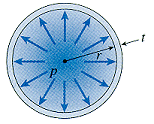pressure
vessel
shell structures
thin-walled vessels
|
  |
Spherical Pressure Vessels
pressure vessel a closed structure containing liquids or gases under pressure
goal: determine the stresses and strains in the walls of these structures due to the internal pressures from the compressed gases or liquids
shell structures
where the walls of the structure are thin in comparison to their radii and lengths (e.g. roof domes, boilers, airplane wings, submarine hulls)
thin-walled vessels
where the ratio of radius r to wall thickness t is greater than 10
grenade example
from Advanced Imaging, May 2006, page 16.stress distribution
see M14.1
A pressurized sphere is subjected to uniform tensile stresses σ in all directions. (biaxial stress state)
σ1 = σ2 = pr / 2t
σ3 = 0
τmax = σ / 2 = pr / 4t
limitations of thin-shell theory
- The wall thickness must be small in comparison to the other dimensions. (the ratio r/t should be 10 or more)
- The internal pressure should exceed the external pressure. (to avoid inward buckling)
- The analysis presented in this section is based only on the effects of internal pressure. (the effects of external loads, reactions, and the weight of the structure are not considered)
- The formulas derived in this section are valid throughout the wall of the vessel except near points of stress concentrations.